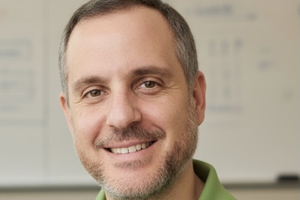“Are we going to do the fun math?” The question, asked by a fifth grade student, greeted Brittany Hess in a classroom when she arrived to coach teachers. To Hess, a member of a Penn GSE team that is building a national model for math instruction through a partnership with thirteen public elementary schools in West Philadelphia, the question was an endearing sign of success.
“We’re doing really challenging problems that some people would look at and say, ‘Are you really going to do that with students of that age?’” says Hess. “But the students are so engaged, and they love learning in that way.”
Funded by a four-year, $2.9 million grant from the National Science Foundation and led by Penn GSE faculty member Caroline B. Ebby, GR’97, the project is researching and developing instructional leadership in schools, creating professional development with the potential to be replicated on a broad scale. Called the Responsive Math Teaching (RMT) project, it helps math teachers in kindergarten through eighth grade shift away from traditional instruction in which the teacher demonstrates how to solve problems. Instead, teachers put students’ thinking at the forefront.
“Current research in math education says that students should be actively involved in meaning-making and engaged in solving problems during class,” says Dr. Ebby. “At its heart, the project is about being responsive to student thinking throughout a math lesson.”
By cultivating best practices in a network of public schools that includes some of the lowest-resourced and lowest-performing schools in the city, the RMT project reflects Penn GSE’s longstanding commitment to underserved students and urban education. The School’s work with The School District of Philadelphia, comprising more than four hundred programs in 250 schools, represents a national model of partnership between a university and an urban district.
Begun in person and continued virtually due to COVID-19, the RMT project is one of several groundbreaking initiatives led by Penn GSE in Philadelphia, the poorest major city in the United States. By creating learning communities for practitioners, the projects highlighted below are establishing national models—and improving children’s lives both in and outside of school.
“Philadelphia is at the heart of national conversations about education reform,” says Penn GSE Dean Pam Grossman. “At Penn GSE, we’re committed to putting our research to work to develop teachers, leaders, and resources in ways that can help unlock opportunities for children in Philadelphia and across the nation.”
Putting Students’ Thinking at the Center of Math Class
Through a three-year training program, Ebby and her team are preparing math teachers not only to put students in an active role, but also to lead professional development for their peers.
Under the new teaching approach, class time is often spent on one math problem, which the whole class solves. Problems are constructed to have multiple solutions, and students are encouraged to attempt an approach and explain their thinking to the class. For example, one problem asks how 36 crackers can be shared equally between friends. Rather than provide a given number of friends, it prompts students to think about all the different ways to share the crackers equally—and discover a mathematical operation (division) in the process.
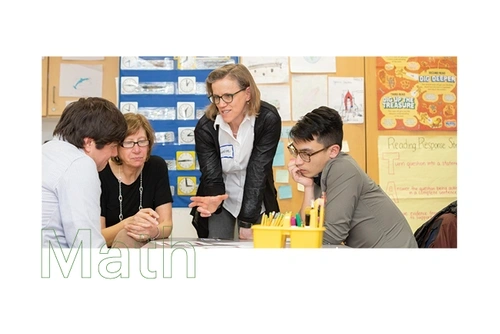
“You can use the problem and get to different mathematical goals that are standards-based,” says Ebby. Guiding such a lesson without solving the problem for the students is a complex task. “It requires a whole new set of skills for teachers around questioning, representing student thinking, and facilitating discussions,” she says.
To address that challenge from the ground up, the first year of the professional development program, “Experience,” puts teachers in the role of learners experiencing the approach for the first time. “We need to help teachers shift their understanding of what mathematics is,” says Ph.D. student Lindsay Goldsmith-Markey, who has led the development and facilitation of the Experience year.
Mary Ellen Stevens, a fifth- and sixth-grade math teacher at Middle Years Alternative School, is currently in the Experience year. “One of the most amazing things to me is that it brought back that feeling of struggle in math class,” she says. She recalls being confronted with a complex problem during a session. “I had a pep talk with myself and said, ‘If you are telling children every day to persevere, then you have to do this.’”
The members of Ebby’s team draw on their own considerable teaching experience to lead and organize the sessions. Along with Hess and Goldsmith-Markey, the members include Joy Anderson Davis, C’96, GRD’17; research coordinator Lizzy Pecora; and Ed.D. student Jennifer Valerio.
The program’s second year, “Teach,” moves participants from the role of learner to teacher. In addition to meeting for group sessions with Goldsmith-Markey, participants receive one-on-one mentoring from Valerio, Hess, and Davis.
“We’ve spent time in their classrooms,” says Dr. Davis. “We sometimes co-teach. We support and facilitate teachers’ planning, observe, provide feedback, and intentionally connect teachers who can learn with and from each other.”
In the process, teachers may confront their own doubts about whether students in low-performing schools can handle the open-ended approach, according to Penn GSE Senior Lecturer Caroline Watts, director of school and community engagement and co-leader of the RMT project.
“Letting the students do the math is often the hardest part,” says Dr. Watts. “A lot of committed teachers aren’t sure their students will be able to learn in this way until they see it.”
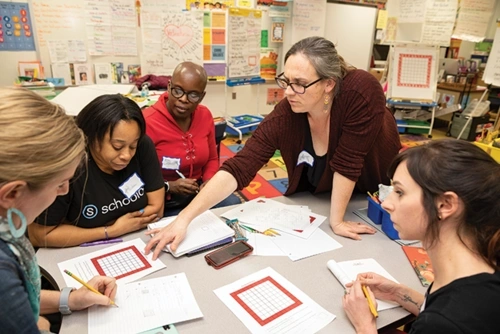
Goldsmith-Markey recalls that one teacher asked her to demonstrate the new method in her classroom before attempting it herself. “It was a big turning point for her to see it happen with her own students,” says Goldsmith-Markey. “She said, ‘I get it now. They can do it.’”
As the teachers bring the approach to their students, they share their experiences with each other at the training sessions.
“Sometimes they say they wish they had done something differently, or that they were really proud of how they handled a particular moment,” says Valerio. “Both are worthwhile to discuss.”
The third year, “Lead,” focuses on how participants can become responsive math leaders in their schools. Ebby and her team have developed a range of options to meet teachers’ needs, understanding that while some will have the time to lead professional development sessions or mentor colleagues, others will find it more feasible to invite colleagues to observe their classrooms. The goal is for teachers to maintain and grow the training in their schools after completing the RMT program—and for the model to be adopted by other schools.
“The idea of working alongside a university to build up skilled practitioners and then transition those teachers to become leaders in their buildings is a unique model, in my experience,” says Melissa Gude, the District’s professional learning specialist for the West Philadelphia network, who also spent years working in Chicago and Nashville schools. “It’s a huge potential win, not only for our network, but for other schools if the model is replicated.”
As the COVID-19 crisis developed this spring, Ebby’s team continued working online with partner schools, devising strategies to provide virtual professional development sessions and coaching.
According to participants, the project is already making a difference. Tiffany Moyer, a school-based teacher leader at Overbrook Elementary School, reports, “Students take more ownership of their learning. New things that they learn are more meaningful because they’ve discovered them on their own.” Now in the Lead year of the program, Moyer has taken on a number of leadership roles—helping participants in the Teach year, mentoring a teacher at her school, and planning schoolwide professional development.
Chris Powers, a math coach at Powel Elementary School who is in the Teach year, says of the program, “I absolutely love it. I’m excited to be part of a project that helps teachers, and in turn, students, to think about math more deeply.” The best part, he says, is that problem solving equips students for much more than math class. “This is not just a test-taking strategy. This is a life strategy,” he says. “Every day in our lives we have to consider information we have and use it to solve problems.”
Inviting Students to Make Sense of Literature
Teaching is often a solitary task, as each educator strives behind closed doors to reach a classroom of students. But for reading and social studies teacher James Lindberg, several times a year it became a team effort. After a morning of planning together, he and several of his colleagues at the Andrew Jackson School in The School District of Philadelphia, along with Penn GSE Assistant Professor Sarah Schneider Kavanagh and her researchers, proceeded to a classroom full of students to teach together.
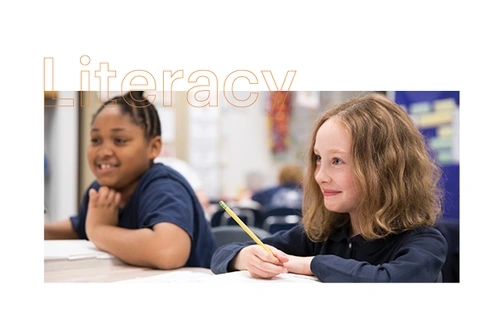
“We’d have it structured so that each teacher had their own specific parts to do,” says Lindberg. Taking turns, the teachers passed the chalk to each other—and even sometimes called a “time out” to discuss their next steps. But their goal was to do as little of the talking as possible as they strove to put students in fourth through eighth grade in charge of analyzing literary texts.
“One of the things we’re trying to combat with this work is the fact that classrooms can be places where teachers talk and students listen,” says Dr. Kavanagh. Her work with the school represents one site of The Labs Project, which is funded at four institutions by a $2.5 million grant from the James S. McDonnell Foundation. “We want students to be the ones who are doing most of the cognitive lift and wrestling through ideas,” she says.
Like Caroline Ebby and the Responsive Math Teaching team, Kavanagh aims to give teachers the support they need to adopt a student-centered approach that may feel unfamiliar. Rather than explain the meaning of a text, the teachers are meant to prompt the students to make sense of the material aloud in discussion.
“We know from research that students learn best and retain the most information when they’re able to engage in discussion and teach each other,” says Kelly Espinosa, principal of the Jackson School, who partnered with Kavanagh’s team as part of her school-wide goal of improved literacy instruction.
Lessons are tied to standards such as those set forth in the Common Core State Standards for English Language Arts, which emphasize critical thinking, problem solving, and analytical skills.
“This is really about students making connections between the literature and their lives and giving them the agency to make sense of it together. We talk a lot about there not being right and wrong answers,” says Liz Gotwalt, who along with Chenelle Boatswain is one of two Penn GSE Ed.D. students working as research assistants on the project.
The texts that Kavanagh and the teachers have discussed with students address another goal of the project—to help teachers bring more literature by authors of color, and about racial identity, into the curriculum. It is an aim that fits Espinosa’s vision for Jackson. “We have over twenty world heritages represented in our school,” she says. “It’s really important to me to let students see themselves in the books we’re reading.”
That goal adds another layer to the teachers’ learning. “It can be daunting to talk about race openly in classrooms,” says Kavanagh. “Our teachers are committed to doing that together, and in ways that will nurture and empower their students.”
Discussions of works such as “My Name” by Sandra Cisneros have brought students into contact with protagonists who are sorting out questions of their own cultural identities. In the story, a Mexican-American girl around the students’ age reflects on her name, Esperanza, and what it means to her. Clues in the story suggest that Esperanza has a complex relationship with her name.
“We’ve had really interesting discussions about how the character feels about her name,” says Gotwalt. “The students almost always will say at first that she doesn’t like it. But then, as they build on each other’s ideas and the teacher asks questions, it becomes more complicated.”
Key to the project is the learning community it creates for teachers. “Student-centered teaching is a difficult thing to learn,” Kavanagh says. “Having other teachers around you who are trying to do the same thing can help you feel safe enough to keep going.” Having conducted approximately two years of the classroom work prior to the COVID-19 crisis this spring, Kavanagh is looking to the project’s next phase. She and the leaders of The Labs Project’s other sites, which are addressing other subject areas, ultimately aim to have participants from across the country facilitate learning experiences for other teachers.
For Lindberg, the team teaching approach has made a difference. “When I take it back to my own classroom, I see the lesson run even smoother than it did the first time,” he says. He reports a transformation of discussions in his classroom, where he and the students would pass around a “talking piece” (a squishy ball) to take turns speaking. Video taken at the beginning of the school year shows students frequently sending the ball back to him. A later video tells a different story. “Students were throwing it to each other, and seven or eight students were speaking before it made its way back to me,” he says. That shift, he says, means power is residing in students’ hands. “It sets them up to take on leadership roles in their lives.”
Improving Children’s Lives Through Data
How can limited funding for prekindergarten be invested to help the children who need it most? How can case workers better assess the risks facing children? States, cities, and counties across the country are able to use information about children’s lives in and outside of school to answer questions like these, thanks to integrated data systems made possible by the pioneering work of Penn GSE’s Dr. John W. Fantuzzo, Albert M. Greenfield Professor of Human Relations, and Penn Social Policy & Practice’s Dennis P. Culhane, Dana and Andrew Stone Chair in Social Policy.
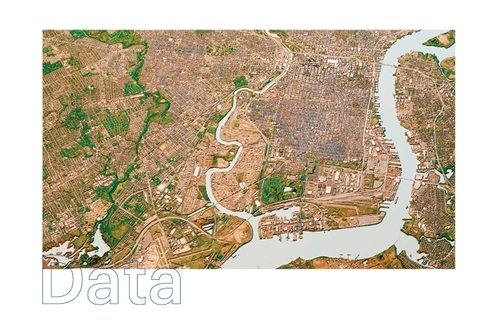
“We want to be serving the most vulnerable citizens with what we affectionately call ‘real and ready’ research,” says Fantuzzo, also director of the Penn Child Research Center. “Real means that it’s evidence-based. Ready means that it can be used in real time to help people.”
While the use of “big data” has transformed business, allowing companies to analyze vast quantities of information about customers, government agencies have typically maintained separate databases for education, housing, juvenile justice, mental health, and other areas. During the past two decades, Fantuzzo and Culhane have established best practices for overcoming the legal and operational challenges to integrating such data and putting it to practical use while vigilantly protecting privacy.
The two cofounded KIDS, one of the nation’s first integrated data systems, in Philadelphia in 2000 and went on to expand the approach nationally, establishing the Actionable Intelligence for Social Policy (AISP) initiative in 2008 and developing it with funding from the John D. and Catherine T. MacArthur Foundation. Their book, Actionable Intelligence: Using Integrated Data Systems to Achieve a More Effective, Efficient, and Ethical Government, published in 2015, sets forth their approach to partnering with school systems, cities, municipal governments, and states to improve social services.
AISP expanded its reach dramatically thanks to grants from the MacArthur Foundation, the Laura and John Arnold Foundation, the federal Social Innovation Fund, and the Annie E. Casey Foundation. These made it possible to create a national, eighteen-month training and technical assistance program for state and local governmental staff. The program has grown the network from an original eight states and municipalities to a current total of thirty-one, with a reach covering nearly 55 percent of the U.S. population.
“It’s exponential growth in terms of training people to have the capacity for integrated data in their state or county,” says Della Jenkins, executive director of AISP. “We’ve become a much larger network of communities that get together to talk through what’s happening on the ground.”
AISP sites have used integrated data to address a range of problems. For instance, Los Angeles County, California, has developed recommendations to better address the needs of homeless adults. South Carolina has improved the delivery of mental health services to citizens in rural areas. Allegheny County, Pennsylvania, has created a screening tool so that child welfare investigations can better assess children’s risk and safety.
In Philadelphia, Fantuzzo and Katie Barghaus, GR’12, senior research investigator for AISP and executive director of Penn Child Research Center, worked with colleagues to address an urgent need for expanded prekindergarten. With a childhood poverty rate of 37 percent, Philadelphia is home to a young population that is vulnerable to a number of risks—such as low birth weight, homelessness, and maltreatment. “Research has revealed the power of early child-hood education to offset the effects of such risks,” says Dr. Barghaus.
When Philadelphia Mayor Jim Kenney appointed a commission to expand prekindergarten access, the group turned to the Penn Child Research Center to help them make the most effective investment of an initial $60 million. They worked with the city’s Data Management Office to create a map indicating the geographic distribution of three- and four-year-old children facing multiple risks. Information from the city’s integrated data system, now known as CARES, made the task possible.
The team overlaid the map with another showing the locations of high-quality prekindergarten slots across the city—and extracted a final map of the areas with the highest risk for children and the least access to high-quality prekindergarten. The city went on to invest in those areas, known as prekindergarten “deserts,” increasing the available slots by 113 percent.
Now, as the city moves to expand the initiative, with an ultimate goal of universal prekindergarten, Fantuzzo and Culhane, along with other colleagues from Penn GSE, Penn Social Policy & Practice, and Penn Nursing, are continuing to work with the city, with support from the William Penn Foundation and Penn Futures Project, the latter a partnership between the three schools.
With a new grant from the Bill & Melinda Gates Foundation, AISP will better document the national landscape of integrated data and improve the use of data to support economic mobility. Fantuzzo envisions that the future will bring increased collaboration across sites to address issues like early childhood education access. “What we want to do now is to create learning communities based on shared high-priority social problems and generate models for the nation,” he says.
Ultimately, integrated data is about people, not numbers. “We’re measuring what’s working and how we can do better for people,” says Jenkins. “This work is really about making sure that people are at the center of decision making when it comes to policy and programs.”
And whether through integrated data or student-centered learning, Penn GSE is dedicated to enriching children’s lives.
This article appeared in the Spring 2020 issue of The Penn GSE Magazine.
Media Inquiries
Penn GSE Communications is here to help reporters connect with the education experts they need.



